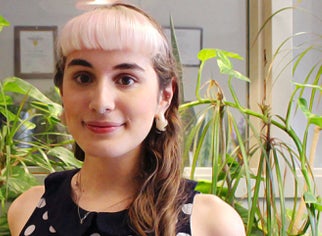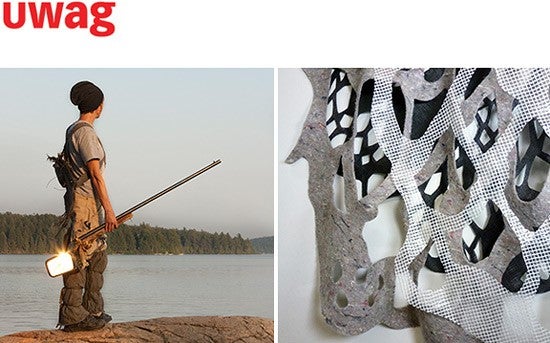
Fine Arts student Melissa Johns reviews the current University of Waterloo Art Gallery (UWAG) exhibition of the works of Elinor Whidden and UWaterloo alum Barbara Hobot. The story originally appeared in the Imprint, January 19, 2016 issue.
The University of Waterloo Art Gallery’s latest double feature, Rearview / Strong Bonds, pairs two bodies of thought-provoking sculptural works.
Rearview is a collection of works produced by artist Elinor Whidden over the course of seven years, shown together for the first time. Made from scavenged auto parts, Whidden constructs North American artifacts like snowshoes, tents, and guns. Each work is paired with photographs that depict Whidden as an explorer, immersed in natural landscapes and using her sculptures to facilitate adventure.

“This body of work really started when I went to Buffalo to do my master’s. It was a really car-centered culture and I’d never lived in a car-centric city before,” Whidden said. “I tried to ride my bicycle everywhere and it was, quite frankly, impossible.
“When I was in Buffalo, I cut up a whole car and turned it into canoes [and] knapsacks, and portaged it around Niagara Falls. So it’s this idea of flipping the way that we use cars, and thinking about the physical power of the human body as opposed to driving around.”
Whidden has travelled across Canada and the United States for the last decade, using her sculptural works in performative interventions that explore history and landscape.
“It was sort of looking to history, looking to the opening up of our country and realizing that, strangely, in a lot of cases, a lot of the earlier fur trade routes in colonial North America have literally been paved over and become the throughways of automobiles,” she said.
Whidden’s investigations are concerned with both the contemporary and historical, commenting on shifts in culture and our relationship with the environment. Transforming herself into a heroic character, Whidden’s approach is a tongue-in-cheek examination of the nation’s contentious past.
“I was looking at how this legacy of colonialism that brought the white man, for lack of a better word, to this country,” she said. “In some ways, I see a kind of colonial imprint with cars as well, with the way we go and fight for oil or the way that we have this impact on the landscape ... I was trying to make this equation for looking to our history and understanding the ways that transportation opened up this land [as well as] making a comment on our current system.”
Like a harbinger of an environmentally volatile future, Whidden is frequently depicted with a rearview mirror attached to her walking stick and gun.
“I guess it came from an environmental point of view,” she said. “I actually went to university before art school and did environmental studies, and learned a lot about the imprint of the cars, carbon culture on the land. And then when I got into doing art I kind of carried some of those issues into the work.”
Playing with the romanticizations of the lone wanderer and the consequences of western expansionism, catastrophe is a prominent theme in the collection. One of the most notable works in the gallery space is a massive pile of welded buffalo skulls — a reference to the bygone indigenous custom of the buffalo jump, wherein bison would be driven off of cliffs en masse. Despite being a long-practiced method of hunting, American bison were slaughtered to the point of near extinction during the 19th century.
“[Head-Smashed-In-Engine-Block-Buffalo-Jump] was kind of my grand finale, like I’ve cut up enough cars for a lifetime,” Whidden said. “I’ve started doing bodies of work with scavenged electronics, and it comes from the same concern. I’m really into this Mad Max kind of scavenging aesthetic and making these artifacts or relics ... I think for me the photography came from making pieces of sculpture that needed to be animated or used in some way.”
Strong Bonds, meanwhile, is an exploration by UW alumnus Barbara Hobot into the material relationship between various interdisciplinary media. The abstract forms found in the second gallery space are a result of translating ideas and forms from medium to medium.
“It’s extremely experimental in that I take a material and I start playing with it. A lot of times it’ll be months before I figure out what the final formation will be,” Hobot said. “A lot of the works influence each other as well, so I might make a drawing and then the shapes of that drawing dictate the composition of a sculpture. So they all sort of influence each other in an unplanned way.”
The pieces in Strong Bonds feature felt, rubber, vinyl, tarpaulin, and clay. They use overlapping and employ negative space. Hobot’s method involves minimizing the appearance of her involvement with the final result.
“What I really like is diminishing my control in the act of creation,” Hobot said. “I think there are more interesting things than just my intention and my feelings, or my thoughts. So I like the idea of giving power or a voice to something other than me and even something that is not human. A piece of felt, rope, or netting, I want to see what those like to do with as little of my input as possible.
“I think giving up a little bit of control and giving voice to things other than a human-centric voice is a way of opening up the way we appreciate the things around us, being a little bit more open minded and maybe a little bit less self-centered.”
Rearview / Strong Bonds is on display until March 5, at the University of Waterloo Art Gallery inside East Campus Hall.